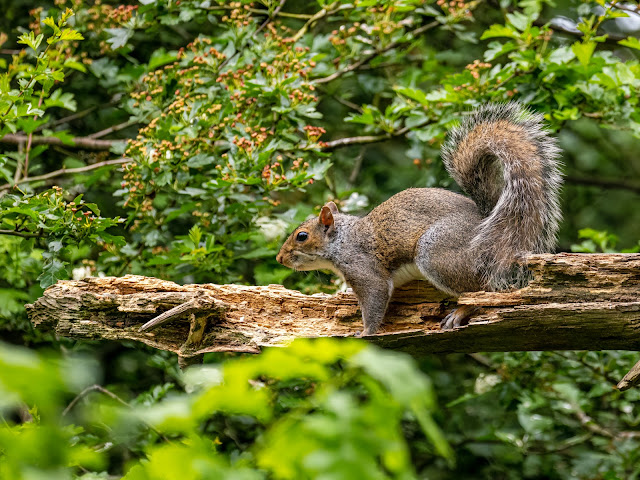On 5th June 2023, I picked up my rental car in Chelmsford. From the bus to Chelmsford, I saw 2 Brown Hares in a field just past “The Ship” pub in West Hanningfield.
Having picked up my rental car, I visited the following sites:
EWT Abberton Reservoir, Essex
EWT Wrabness, Essex
NWT Weeting Heath, Norfolk
The huge expanse of EWT Abberton Reservoir is one of Europe's top wetland sites. It is of international importance as a safe haven for wild ducks, swans and other water birds, whether resident, passing through on migration or over-wintering. It has also very recently become an important nesting site for Spoonbills, this species being my target.
I didn’t spend long at the site and only viewed from the Layer-de-la-Haye causeway which provides views of the trees in which Grey Herons, Little Egrets and the Spoonbills all nest.
In addition to 2 or possibly 3 Spoonbills, a group of c.100 Swifts plus c.5 Common Terns were notable.
After the brief stop-over visit at EWT Abberton Reservoir, I then drove north to EWT Wrabness.
EWT Wrabness comprises hedgerows, scrub and grassland plus views overlooking the River Stour estuary. It is primarily known as a breeding location for Turtle Dove, a rapidly declining species which can be very difficult to locate now in the UK although this site remains a stronghold in Essex.
It proved relatively easy to locate Turtle Doves, initially by their distinctive “purring” call, and I saw 3 males and heard at least 3 other males although there may have been some double-counting.
The highlights during my visit were as follows (heard only records in italics): Turtle Dove (3 seen and at least 3 other “purring” males heard), Nightingale (1 singing male seen and at least 3 other singing males heard), Lesser Whitethroat (2 singing males), Common Whitethroat (3 singing males seen and at least 2 other singing males heard), Sedge Warbler (1 singing male), Blackcap (1 singing male), Chiffchaff (at least 5 singing males), Swallow (3), Cetti’s Warbler (2 singing males), Yellowhammer (1 singing male), Linnet (at least 5), Mistle Thrush (1), Green Woodpecker (3), Common Buzzard (1)
Here are some photos from my visit ....
Photo: male Turtle Dove
After an excellent walk around EWT Wrabness, I drove further north to NWT Weeting Heath in Norfolk.
NWT Weeting Heath is a 141.8 hectare reserve which is managed by the Norfolk Wildlife Trust. It is a Site of Special Scientific Interest and a National Nature Reserve and it is also part of the Breckland Special Area of Conservation and a Special Protection Area.
NWT Weeting Heath is the best site in the country to see the rare breeding Stone Curlew. The species requires open, stony ground with short vegetation to breed, making the close-cropped grass and lichen heath of NWT Weeting Heath an ideal site. As well as the Stone Curlew, NWT Weeting Heath is also home to a range of other heathland and woodland species.
My main target species was obviously the Stone Curlew, a bird that I usually record at NWT Weeting Heath each year. It was good to catch up again with this enigmatic species and I quickly found 2 adult birds plus at least a single well-grown chick from the western hide, albeit views were a little hampered by the heat haze which is always an issue at this site. Nonetheless, I did manage to get some heavily cropped record photos.
The highlights during my visit were as follows (heard only records in italics): Stone Curlew (2 adult birds plus at least a single well-grown chick), Curlew (1), Oystercatcher (1), Lapwing (6), Mistle Thrush (1), Siskin (2), Stock Dove (2), Skylark (1 singing male)
Unfortunately, this year, I could not locate a Spotted Flycatcher in the woodland although this increasingly scarce species had been recorded on site as usual.
Photo: heavily cropped record photo of Stone Curlews
Photo: heavily cropped record photo of Stone Curlew
Photo: Jay
Photo: Grey Squirrel
Photo: Grey Squirrel
My initial plan had been to finish the day at Westleton Heath in Suffolk for some Nightjar watching. However, this would have involved a 55 mile and 1:30 hour drive to get there and then a 87 mile and 1:45 hour drive to get home after it had gone dark. I would have arrived home after midnight, not ideal when I wanted to leave for Wales at 4 a.m. the next day. Nightjars were deferred until another time!
#DefendNature .... Please help save and enhance our laws that protect our environment and wildlife










No comments:
Post a Comment
If you feel like commenting on my blog, you can contact me by completing the comment form below. I will respond to all comments and enquiries and constructive criticism will always be welcomed.